check engine LINCOLN CONTINENTAL 1996 Customer Assistance Guide
[x] Cancel search | Manufacturer: LINCOLN, Model Year: 1996, Model line: CONTINENTAL, Model: LINCOLN CONTINENTAL 1996Pages: 320, PDF Size: 1.8 MB
Page 247 of 320
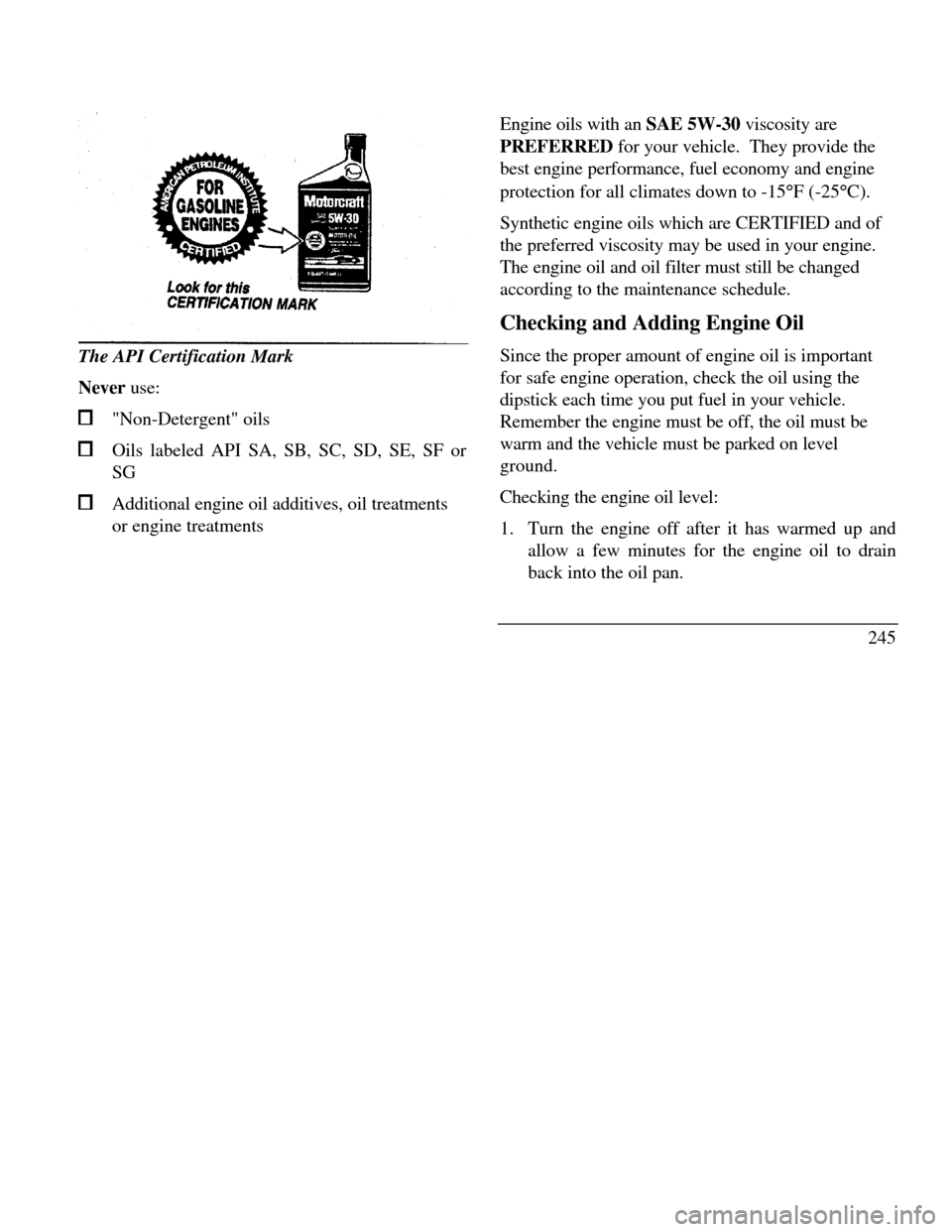
The API Certification Mark
Never use:"Non-Detergent" oilsOils labeled API SA, SB, SC, SD, SE, SF or
SGAdditional engine oil additives, oil treatments
or engine treatmentsEngine oils with an SAE 5W-30 viscosity are
PREFERRED for your vehicle. They provide the
best engine performance, fuel economy and engine
protection for all climates down to -15°F (-25°C).
Synthetic engine oils which are CERTIFIED and of
the preferred viscosity may be used in your engine.
The engine oil and oil filter must still be changed
according to the maintenance schedule.
Checking and Adding Engine Oil
Since the proper amount of engine oil is important
for safe engine operation, check the oil using the
dipstick each time you put fuel in your vehicle.
Remember the engine must be off, the oil must be
warm and the vehicle must be parked on level
ground.
Checking the engine oil level:
1. Turn the engine off after it has warmed up and
allow a few minutes for the engine oil to drain
back into the oil pan.
245
Page 248 of 320
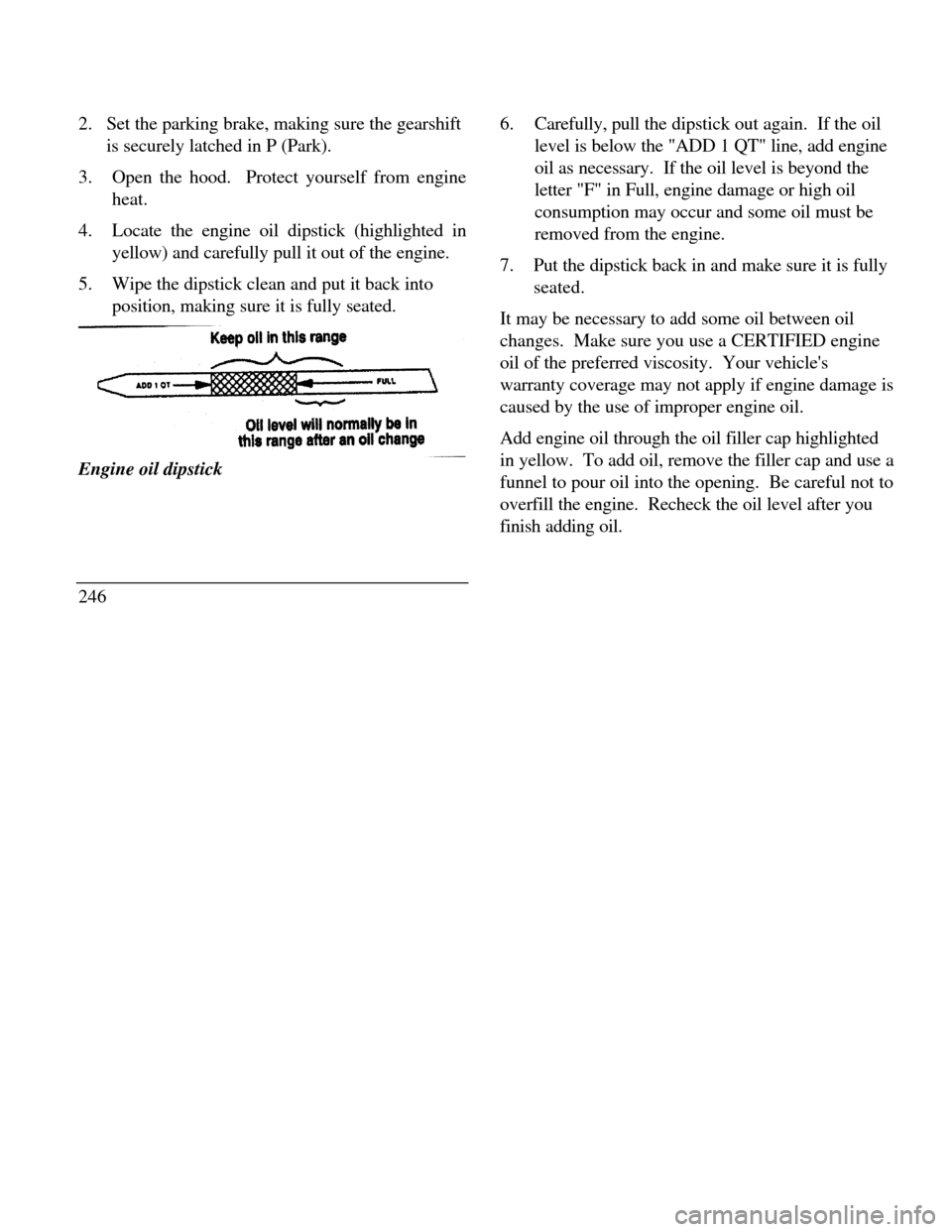
2.Set the parking brake, making sure the gearshift
is securely latched in P (Park).
3.Open the hood. Protect yourself from engine
heat.
4.Locate the engine oil dipstick (highlighted in
yellow) and carefully pull it out of the engine.
5.Wipe the dipstick clean and put it back into
position, making sure it is fully seated.Engine oil dipstick
2466.Carefully, pull the dipstick out again. If the oil
level is below the "ADD 1 QT" line, add engine
oil as necessary. If the oil level is beyond the
letter "F" in Full, engine damage or high oil
consumption may occur and some oil must be
removed from the engine.
7.Put the dipstick back in and make sure it is fully
seated.
It may be necessary to add some oil between oil
changes. Make sure you use a CERTIFIED engine
oil of the preferred viscosity. Your vehicle's
warranty coverage may not apply if engine damage is
caused by the use of improper engine oil.
Add engine oil through the oil filler cap highlighted
in yellow. To add oil, remove the filler cap and use a
funnel to pour oil into the opening. Be careful not to
overfill the engine. Recheck the oil level after you
finish adding oil.
Page 249 of 320
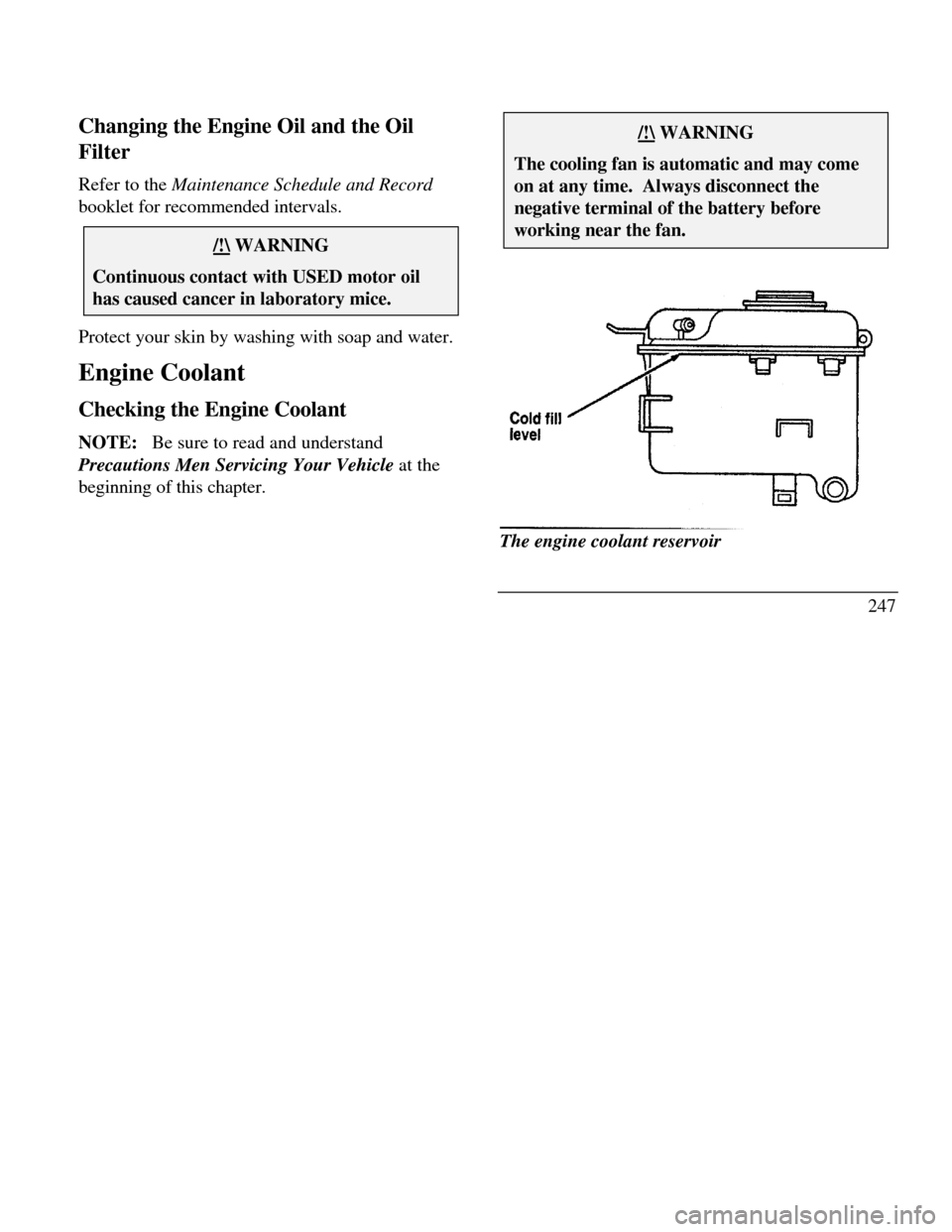
Changing the Engine Oil and the Oil
Filter
Refer to the Maintenance Schedule and Record
booklet for recommended intervals./!\ WARNINGContinuous contact with USED motor oilhas caused cancer in laboratory mice.Protect your skin by washing with soap and water.
Engine Coolant
Checking the Engine Coolant
NOTE: Be sure to read and understand
Precautions Men Servicing Your Vehicle at the
beginning of this chapter./!\ WARNINGThe cooling fan is automatic and may comeon at any time. Always disconnect thenegative terminal of the battery beforeworking near the fan.Cold fill levelThe engine coolant reservoir
247
Page 250 of 320
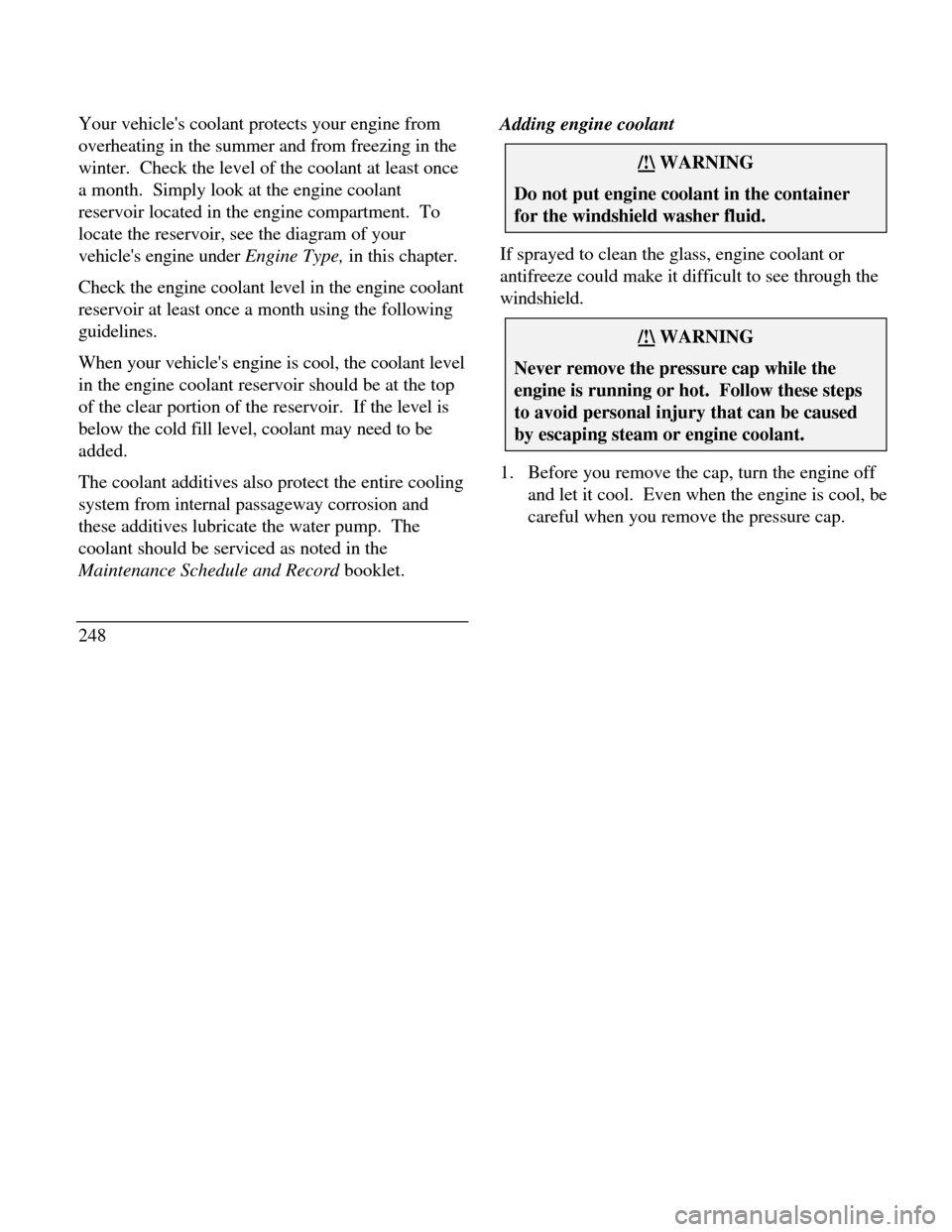
Your vehicle's coolant protects your engine from
overheating in the summer and from freezing in the
winter. Check the level of the coolant at least once
a month. Simply look at the engine coolant
reservoir located in the engine compartment. To
locate the reservoir, see the diagram of your
vehicle's engine under Engine Type, in this chapter.
Check the engine coolant level in the engine coolant
reservoir at least once a month using the following
guidelines.
When your vehicle's engine is cool, the coolant level
in the engine coolant reservoir should be at the top
of the clear portion of the reservoir. If the level is
below the cold fill level, coolant may need to be
added.
The coolant additives also protect the entire cooling
system from internal passageway corrosion and
these additives lubricate the water pump. The
coolant should be serviced as noted in the
Maintenance Schedule and Record booklet.
248Adding engine coolant/!\ WARNINGDo not put engine coolant in the containerfor the windshield washer fluid.If sprayed to clean the glass, engine coolant or
antifreeze could make it difficult to see through the
windshield./!\ WARNINGNever remove the pressure cap while theengine is running or hot. Follow these stepsto avoid personal injury that can be causedby escaping steam or engine coolant.1. Before you remove the cap, turn the engine off
and let it cool. Even when the engine is cool, be
careful when you remove the pressure cap.
Page 251 of 320

2.When the engine is cool, wrap a thick cloth
around the cap and turn it slowly counter-
clockwise to relieve pressure.
3.Step back while the pressure releases.
4.When you are sure that all the pressure has
been released, use the cloth to turn and remove
cap.
5. Stand away from the reservoir opening. Hot
steam may blow out or hot engine coolant may
even splash out./!\ WARNINGFailure to follow these instructions couldresult in serious personal injury from hotengine coolant or steam blowout and/ordamage to the engine cooling system orengine.To find out how much engine coolant mixture your
vehicle's coolant system can hold, see Refill
capacities for fluids in the Index.
Add engine coolant only to the coolant reservoir.
If the coolant level is low, add to the reservoir a
50/50 or appropriate mixture of water and the type
of engine coolant that Ford specifies. You may add
water by itself only in an emergency, but you should
replace it with a 50/50 mixture as soon as possible.
Check the engine coolant again the next few times
you drive your vehicle.
Have your dealer check the engine cooling system
for leaks if you have to add more than a quart (liter)
of engine coolant more than once a month.
Ford Premium Cooling System Fluid is an optimized
formula that will protect all metals and rubber
elastomers used in Ford engines for four years or
50,000 miles (80,000 km). It is not necessary and
not recommended to use supplemental coolant
additives in your vehicle. These additives may harm
249
Page 254 of 320

Select maximum heater temperature and fan
speed settings. Position control to discharge air
at A/C vents in instrument panel. Start engine and allow to idle. While engine is
idling, feel for hot air at A/C vents.
NOTE: IF AIR DISCHARGE REMAINS COOL
AND ENGINE TEMPERATURE GAUGE DOES
NOT MOVE, SHUT ENGINE OFF
IMMEDIATELY. This is an indication of low
coolant level and/or air pockets in coolant system.
Allow engine to cool and repeat the previous steps. Allow to idle until normal operating temperature
is reached. Hot air should discharge from A/C
vents. The engine temperature gauge should
maintain a stabilized reading in the middle of the
"NORMAL" range and the lower radiator hose
should feel hot to the touch. Shut off the engine and allow to cool down.
252 After the engine cools down, recheck the engine
coolant level. Fill reservoir to the COLD-FULL
level as required.Check for leaks at the draincock, block plug and
vent plug.Recheck the engine coolant level, using the
recommended procedure, after one or two
occasions of vehicle use. Fill to COLD-FULL
level as required.
Battery
Your vehicle may have a Motorcraft maintenance-
free battery. When the original equipment battery is
replaced under warranty it may be replaced by a low-
maintenance battery. See Motorcraft Parts at the
end of this chapter for the proper replacement
battery.
Page 255 of 320

The low-maintenance battery has removable vent
caps for checking the electrolyte level and adding
water. The electrolyte level should be checked at
least every 24 months or 24,000 miles (40,000 km)
in temperatures up to 90'F (32'C) and more often in
temperatures above 90'F (32'C). Keep the
electrolyte level in each cell up to the level
indicator. Do not overfill.
If the level gets low, refill the battery with distilled
water. If necessary, you can add tap water to the
battery, provided the water is not hard or does not
have a high mineral or alkali content. If the battery
needs water quite often, have the charging system
checked for a possible malfunction.
Help Us Protect Our Environment
Ford Motor Company strongly recommends that
used lead-acid batteries be returned to an authorized
recycling facility for disposal.Battery recycling symbol
Because your vehicle's engine is electronically
controlled by a computer, some control conditions
are maintained by power from the battery. If you
ever disconnect the battery or install a new battery,
you must allow the computer to "relearn" its idle
conditions before your vehicle will drive properly.
To let the engine do this, put the gearshift in P
(Park), turn off all the accessories, and start the
vehicle. Let the engine idle for at least one minute.
(Engine must be warm in order to "learn.") Also,
allow approximately 10 miles (16 km) of stop and go
traffic for your vehicle's engine to completely
girelearn" its idle.
253
Page 256 of 320
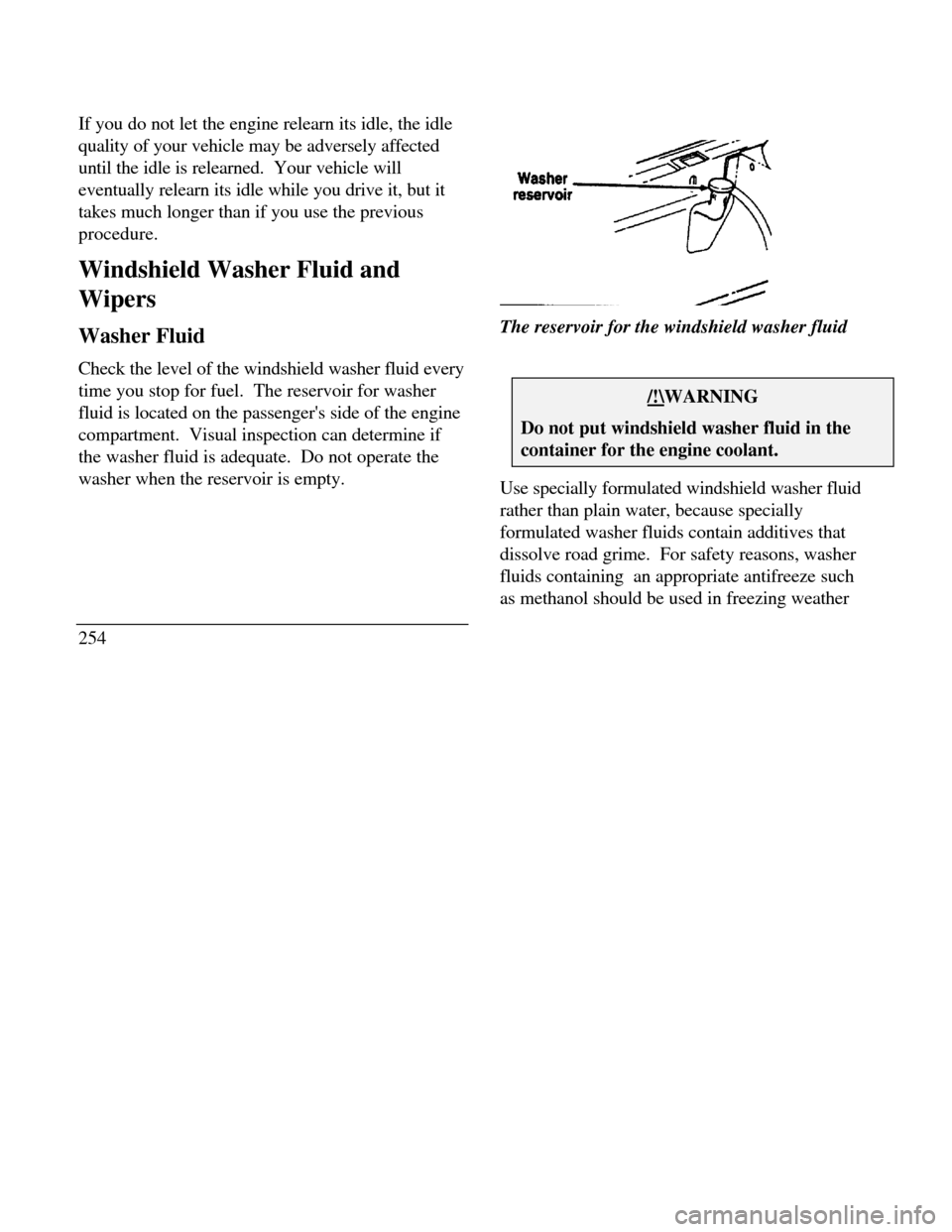
If you do not let the engine relearn its idle, the idle
quality of your vehicle may be adversely affected
until the idle is relearned. Your vehicle will
eventually relearn its idle while you drive it, but it
takes much longer than if you use the previous
procedure.
Windshield Washer Fluid and
Wipers
Washer Fluid
Check the level of the windshield washer fluid every
time you stop for fuel. The reservoir for washer
fluid is located on the passenger's side of the engine
compartment. Visual inspection can determine if
the washer fluid is adequate. Do not operate the
washer when the reservoir is empty.
254Washer reservoirThe reservoir for the windshield washer fluid/!\WARNINGDo not put windshield washer fluid in thecontainer for the engine coolant.Use specially formulated windshield washer fluid
rather than plain water, because specially
formulated washer fluids contain additives that
dissolve road grime. For safety reasons, washer
fluids containing an appropriate antifreeze such
as methanol should be used in freezing weather
Page 263 of 320

See Securitires in the Features chapter for more
information.
Automatic Transaxle Fluid
Under normal circumstances, you do not need to
check the fluid level of the transaxle, since your
vehicle does not use up transaxle fluid. Refer to the
Maintenance Schedule and Record booklet for
replacement intervals. However, if the transaxle is
not working properly - for instance, the transaxle
may slip or shift slowly, or you may notice some
sign of fluid leakage - the fluid level should be
checked.
NOTE: If the vehicle has been operated for an
extended period at high speeds or in city traffic
during hot weather, or pulling a trailer, the vehicle
should be turned off for about 30 minutes to allow
the fluid to cool before checking.Checking the Automatic Transaxle Fluid
With the vehicle on a level surface and the brake fully
applied, start the engine and move the gear shift
selector through all of the gears allowing sufficient
time for each position to engage. Securely latch the
gear shift selector in the P (Park) position. Fully set
the parking brake and leave the engine running.
Wipe off the dipstick cap and pull the dipstick out.
Wipe the indicator end clean. Put the dipstick back
into the filler tube and make sure it is fully seated.
Pull the dipstick out and read the fluid level.
NOTE: Your vehicle should not be driven until
some fluid has been added if the fluid level is below
the bottom dimple on the dipstick and the outside
temperature is above 50°F (10°C). Add only enough
fluid to bring the level above the bottom hole.
261
Page 265 of 320
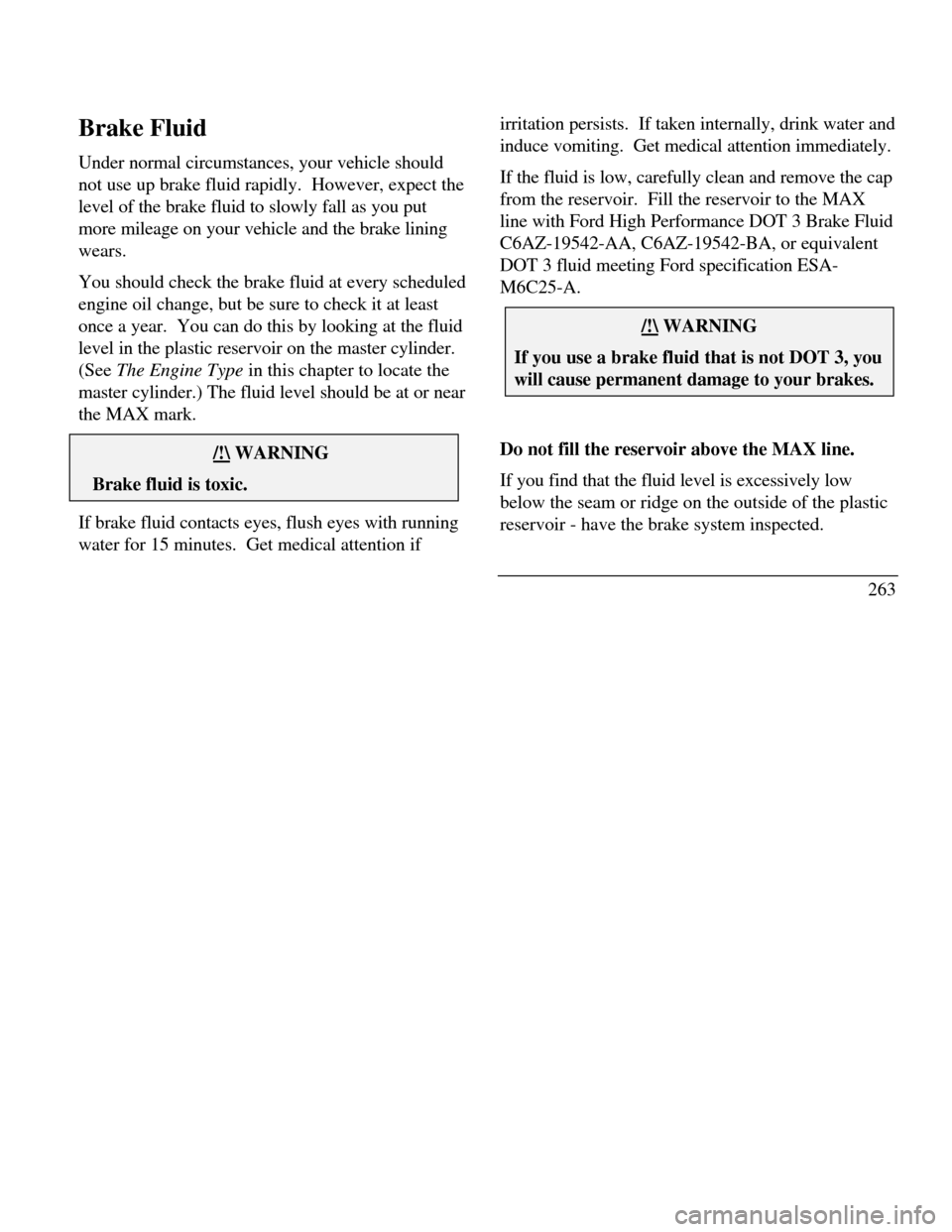
Brake Fluid
Under normal circumstances, your vehicle should
not use up brake fluid rapidly. However, expect the
level of the brake fluid to slowly fall as you put
more mileage on your vehicle and the brake lining
wears.
You should check the brake fluid at every scheduled
engine oil change, but be sure to check it at least
once a year. You can do this by looking at the fluid
level in the plastic reservoir on the master cylinder.
(See The Engine Type in this chapter to locate the
master cylinder.) The fluid level should be at or near
the MAX mark./!\ WARNINGBrake fluid is toxic.If brake fluid contacts eyes, flush eyes with running
water for 15 minutes. Get medical attention ifirritation persists. If taken internally, drink water and
induce vomiting. Get medical attention immediately.
If the fluid is low, carefully clean and remove the cap
from the reservoir. Fill the reservoir to the MAX
line with Ford High Performance DOT 3 Brake Fluid
C6AZ-19542-AA, C6AZ-19542-BA, or equivalent
DOT 3 fluid meeting Ford specification ESA-
M6C25-A./!\ WARNINGIf you use a brake fluid that is not DOT 3, youwill cause permanent damage to your brakes.Do not fill the reservoir above the MAX line.
If you find that the fluid level is excessively low
below the seam or ridge on the outside of the plastic
reservoir - have the brake system inspected.
263